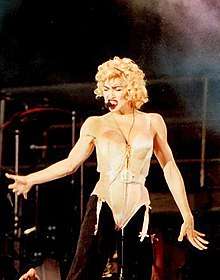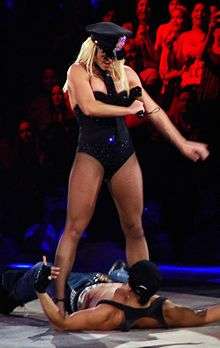Underwear as outerwear
Wearing underwear as outerwear is a fashion trend. Current examples include the display of thongs and bras in women's clothing, and the display of underpants under low-slung pants in men. The trend was initiated by the US singer Madonna in the 80s. As of 2009, the visible wearing of corsets had become fashionable, popularized by stage performers such as Lady Gaga and Rihanna. Wearing underwear as outerwear has historical antecedents in the display of undergarments in the sixteenth and seventeenth centuries.[1]
Celebrities begin trend

From high fashion to mainstream, the popularity of this trend has been fueled by celebrities who wear lingerie and intimate apparel as clothing. Entertainer Madonna began the trend in the 1980s when she wore a cone bra and girdle over her clothing during multiple performances. She first modeled the fashion during her Blonde Ambition Tour in 1990–91 wearing a pink satin cone-breasted corset designed by French designer Jean-Paul Gaultier. Gaultier is famous for emphasizing sexuality by using fetishized garments and was one of the first to incorporate the corset as an integral part of his work.[2]
The underwear as outwear trend was adopted by multiple shows including Sex and the City, in which actors wore a corset, bustier, or bra that was visible. Some performers like Madonna, Lil' Kim, Britney Spears, Christina Aguilera, Rihanna, Nicki Minaj, and Lady Gaga perform with underwear or lingerie only, which has popularized the fashion trend in the news and press. The celebrity-driven trend has been adopted by fashion magazines and fashion blogs which has promoted the idea as a mainstream style.[3][4][5]
Slip dresses were first widely worn in the last decade of the 20th century, when they were made from layered chiffon, polyester satins and charmeuse, and often trimmed with lace.[6]
The idea of underwear as outerwear is part of the deconstruction of trends that has taken place in the 20th and 21st century. Part of the popularity of this trend was brought about by a couple of contemporary lingerie brands such as VPL, The Lake and Stars and alt-fashion lingerie designer Stephanie Paterek (of Love Cage NYC and NYC Sex Trash), and with that concept being heralded by the days modern intimates designers as part of an effort to grab at the elusive ring of crossing over categories. These two brands in particular have been successful in straddling the line between underwear as outerwear by marketing to a contemporary customer who this look appeals to.
Sports bra
_(cropped).jpg)
Sports bras were first invented in 1975, and women have been wearing them under other clothing since then.[7] On July 10, 1999, Brandi Chastain scored the fifth kick in the penalty shootout to give the United States the win over China in the final game of the 1999 FIFA Women's World Cup Final. In celebration, she spontaneously whipped off her jersey, exposing her sports bra. Her act is regarded by some as a historical event that boosted the wearing sports bras on their own.[7][8] From that point forward, sports bras have increasingly been worn as outerwear.[9]
Corset
Although the corset had not been a part of mainstream fashion since the early 1900s, it continued to exist in the fetish and pornographic cultures used for S&M role-play. The sexual liberation movement of 1968 began the re-appropriation of the corset as a symbol of rebellion and "sexual perversity" by young women associated with London’s punk and Goth subcultures. In this context the corset became an item of fashionable outerwear instead of an undergarment. Avant-garde fashion soon began to adopt this trend, with designers such as Vivienne Westwood using the corset in their designs, thus giving corsets in fashion a second life.[2] Women no longer felt the need to wear corsets, but now had the choice to do so. This re-appropriation allowed a symbol historically associated with female oppression, to become reconceived as a symbol of sexual empowerment in fashion.[10]
Many high fashion designers have adopted this contemporary corset trend in clothing items including evening gowns and wedding dresses.[11] With sexual attitudes and behaviors within society becoming much freer, the visible corset has become a socially acceptable form of erotic display.
Public events
No Pants Day is an annual event held in various Western countries, where people publicly wear only underwear and leave their legs exposed. No Pants Subway Ride is a similar event to promote public wearing of underwear on subway trains. Another such event is Undie Run, where people run on street wearing only underwear in their lower body part.
See also
- Bikini in popular culture
- Bikini News
- Bra as outerwear
- Breastaurant
- Camel toe
- Go Topless Day
- Indecent exposure
- Leotard
- Lingerie Football League
- Miss Bumbum
- Sagging
- Samba (Brazilian dance)
- Sexual objectification
- Social impact of thong underwear
- Swimsuit competition
- Upskirt
- Underwear fetishism
- Whale tail
References
- Lisa Jardine (24 October 2008). "Underwear as outerwear". BBC News. Retrieved 2010-02-05.
- Steele, Valarie. “The Hard Body A Muscular Corset.” The Corset: A Cultural History. New Haven & London: Yale UP, 2001. 143-176. Print
- Claudia Croft (December 20, 2009). "Underwear is the new outerwear". Times Online. Retrieved 2010-02-05.
- Alice Fisher (29 November 2009). "Underwear as outerwear". The Observer. Retrieved 2010-02-05.
- Jess Carter-Morely (16 January 2010). "How to dress: Don't get your knickers in a twist". Guardian Online. Retrieved 2010-02-05.
- Amy T. Peterson & Ann T. Kellogg, ed. (2008). The Greenwood encyclopedia of clothing through American history 1900 to the present. Westport, Conn.: Greenwood Press. p. 229. ISBN 9780313358555.
- Komar, Marlen. "The Surprising Feminist History Of The Sports Bra Will Make You Seriously Angry". Bustle. Retrieved 22 March 2019.
- Roberts, Jacob (2017). "Women's work". Distillations. 3 (1): 6–11. Retrieved 22 March 2018.
- Krucoff, Carol (9 August 1999). "Sports Bras Are a Bust for Some". Los Angeles Times. Archived from the original on 6 April 2009. Retrieved 11 September 2009.
- Wilkins, Amy (June 2004). ""So Full of Myself as a Chick": Goth Women, Sexual Independence, and Gender Egalitarianism". Gender and Society. 18 (3): 328–49. doi:10.1177/0891243204264421. JSTOR 4149405.
- Crane, Diana. “Postmodernism and the Avant-Garde: Stylistic Change in Fashion Design.” Modernism/Modernity, 4, (1997), 123-140.
External links
- Tove Hermanson (September 1, 2009). "Innerwear as Outerwear". Thread for Thought blog. Archived from the original on 28 September 2009.
